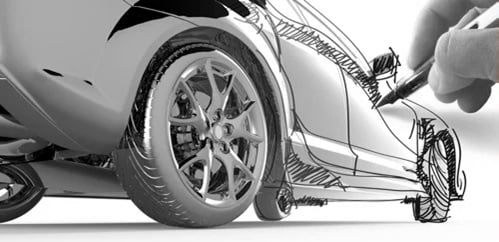There is much to contemplate when converting a vehicle concept into reality. And although one could assert that the fundamental art and approach has remained unchanged since the time of the horseless carriage, one can see that the tools of the trade have changed considerably.
As a case in point, I can remember first hearing the term “virtual proving ground” about twenty years ago while working on a project for a major OEM. Before even learning what the concept actually meant, the terminology implicitly sparkled with the promise of a better tomorrow – or at least the promise of reduced engineering blood, sweat, and tears. Today, the concept of a virtual proving ground is different than it was back then, and I thought it might be worth a brief ramble.
Once Bitten
Twenty years ago the virtual proving ground was conceptualized to be a suite of software tools that could enable vehicle designers to execute vehicle manufacturing and performance verifications from their CAD (Computer-Aided Design) terminals. It was meant to be a paradigm shift rather than a minor re-definition of CAD/CAM (Computer-Aided Design and Manufacturing), and big box software vendors were each jockeying to become the single source provider for the complete application suite that would serve this ambition. The dream was something like this: Accept the draft design for your lower control arm, press the green button to verify understeer gradient and drivability, and then press the blue button to verify manufacturability.
There was about a five year run on all this, and then the whole thing dissolved like a bouillon stock cube in a cup of hot water. The result succeeded in being somewhat soup-like, to be sure, but it was a bit too salty to be palatable and it was lacking in nutrient content. The software vendors came out wounded, their seemingly excellent tools having been rejected by their customers after quite a bit of heavy lifting. The OEMs’ perspective was clear: They vowed never to be fooled again.
And what became of the notion of the virtual proving ground? It went dormant for nearly a decade. So where did it go wrong? And why has the term “virtual proving ground” now resurfaced with such positive results?
Virtual Proving Ground v1.0
Before critiquing the old, original concept of the virtual proving ground, the reference frame should be appreciated. For example, twenty years ago a high-performance desktop PC had a 33 MHz processor and 8 MB of RAM. Gulp. And a single PC of such specification may have actually been a shared resource for a group of, say, 10 vehicle development engineers. CAD resided on UNIX mainframes, with multiple access terminals, thus creating a clear dividing line between design and development work flows (and, dare I say, thought patterns?). The pursuit of real-time - or even moderately efficient - execution of complex vehicle models was left in the hands of universities and ambitious researchers.
With hindsight goggles in place, we can identify a few of the errors that were a part of the first attempts to realize the virtual proving ground concept:
-
Inverted component/system approach – With CAD at the workflow center, the entire process was driven from component considerations, rather than system-level considerations.
-
Absence of subjective criteria – There was no mechanism to create subjective predictions from simulations, nor was there a way to proactively address potential subjective/objective conflict areas.
-
Execution time versus quality – Limited accessibility to computational horsepower forced engineers to choose between speed and solution accuracy, without the possibility of having both.
-
Swiss Army knife approach – The concept of one tool providing everything was not aligned with multi-disciplinary modeling fidelity and specialization requirements. i.e. While a Swiss Army knife indeed provides a corkscrew, it would not be regarded as the best one for tackling a well-seated cork.
Virtual Proving Ground v2.x
Having witnessed and participated in a small portion of this history, I must admit that I cringed just a little when “virtual proving ground” started re-appearing in the automotive lexicon. I’m sure that I’m not alone. However, this time around it is decidedly different, and I have come to embrace it and endorse it in its new and improved form.
Nowadays, the frame of reference is no longer what it was. We are in the era of computation capability that enables real-time simulation of complex systems, which permits such things as Driver-in-the-Loop (DIL) simulation and Human-and-Hardware-in-the-Loop (H2IL) simulation. As such, new opportunities abound.
The virtual proving ground has now been re-invented to be exactly what its name implies: A real driver engages with an imagined vehicle and environment in a way that can actually influence product development. System considerations now drive component-level decisions; Subjective and objective feedback is possible at the pre-prototype stage; Complex vehicle models can be efficiently exercised; Specialty tools can communicate openly and synchronously. That’s not bad for twenty years. I wonder what the next twenty will bring?
To learn more about how emerging Driver-in-the-Loop (DIL) simulator technology is encouraging a virtual proving ground renaissance, download our FREE eBook, Looking down the road: Harnessing the benefits of driving simulator technology:


